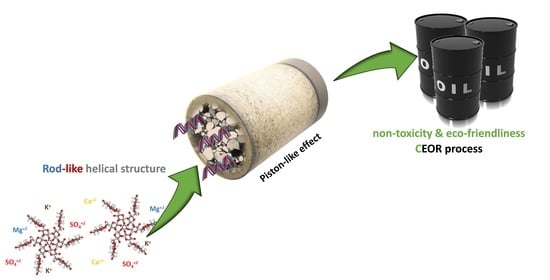Polymers for EOR Application in High Temperature and High Viscosity Oils: Rock–Fluid Behavior
Abstract
1. Introduction
2. Materials and Methods
2.1. Materials
2.2. Methods
2.2.1. Preparation of Polymer Solutions
2.2.2. Injectivity Tests
2.2.3. Inaccessible Porous Volume (IPV) and Adsorption Test
2.2.4. Oil Displacement Tests
3. Results and Discussions
3.1. Injectivity Tests
3.2. Adsorption and Inaccessible Porous Volume (IPV) at Sor Condition
3.3. Oil Displacement Tests
4. Conclusions
Author Contributions
Funding
Acknowledgments
Conflicts of Interest
References
- Al Adasani, A.; Bai, B. Analysis of EOR projects and updated screening criteria. J. Pet. Sci. Eng. 2011, 79, 10–24. [Google Scholar] [CrossRef]
- Al-Mjeni, R.; Arora, S.; Cherukupalli, P.K.; Wunnik, J.N.M.V.; Edwards, J.; Felber, B.J.; Gurpinar, O.; Hirasaki, G.J.; Miller, C.A.; Jackson, C.; et al. Has the time come for EOR? Oilfield Rev. 2010, 22, 16–35. [Google Scholar]
- Manrique, E.J.; Thomas, C.P.; Ravikiran, R.; Izadi Kamouei, M.; Lantz, M.; Romero, J.L.; Alvarado, V. EOR: Current Status and Opportunities. In Proceedings of the SPE Improved Oil Recovery Symposium, Tulsa, OK, USA, 24–28 April 2010; Society of Petroleum Engineers: Richardson, TX, USA, 2010. [Google Scholar]
- Sveistrup, M.; Van Mastrigt, F.; Norrman, J.; Picchioni, F.; Paso, K. Viability of biopolymers for enhanced oil recovery. J. Dispers. Sci. Technol. 2016, 37, 1160–1169. [Google Scholar] [CrossRef]
- Seright, R. Potential for polymer flooding reservoirs with viscous oils. SPE Reserv. Eval. Eng. 2010, 13, 730–740. [Google Scholar] [CrossRef]
- Seright, R.S.; Campbell, A.; Mozley, P.; Han, P. Stability of partially hydrolyzed polyacrylamides at elevated temperatures in the absence of divalent cations. SPE J. 2010, 15, 341–348. [Google Scholar] [CrossRef]
- Seright, R.S.; Seheult, J.M.; Talashek, T. Injectivity characteristics of EOR polymers. In Proceedings of the SPE Annual Technical Conference and Exhibition, Denver, CO, USA, 21–24 September 2008; Society of Petroleum Engineers: Richardson, TX, USA, 2008. [Google Scholar]
- Sabhapondit, A.; Borthakur, A.; Haque, I. Water soluble acrylamidomethyl propane sulfonate (AMPS) copolymer as an enhanced oil recovery chemical. Energy Fuels 2003, 17, 683–688. [Google Scholar] [CrossRef]
- Gaillard, N.; Sanders, D.B.; Favero, C. Improved oil recovery using thermally and chemically protected compositions based on Co-and ter-polymers containing acrylamide. In Proceedings of the SPE Improved Oil Recovery Symposium, Tulsa, OK, USA, 24–28 April 2010; Society of Petroleum Engineers: Richardson, TX, USA, 2010. [Google Scholar]
- Thomas, A.; Gaillard, N.; Favero, C. Some key features to consider when studying acrylamide-based polymers for chemical enhanced oil recovery. Oil Gas Sci. Technol. Rev. d’IFP Energ. Nouv. 2012, 67, 887–902. [Google Scholar] [CrossRef]
- Gaillard, N.; Giovannetti, B.; Leblanc, T.; Thomas, A.; Braun, O.; Favero, C. Improved selection of customized polymers to enhance oil recovery from high temperature reservoirs. In Proceedings of the SPE Latin American and Caribbean Petroleum Engineering Conference, Quito, Ecuador, 18–20 November 2015; Society of Petroleum Engineers: Richardson, TX, USA, 2015. [Google Scholar]
- Seright, R.S.; Wavrik, K.E.; Zhang, G.; AlSofi, A.M. Stability and behavior in carbonate cores for new Enhanced-oil-recovery polymers at elevated temperatures in hard saline brines. SPE Reserv. Eval. Eng. 2020, 1–18. [Google Scholar] [CrossRef]
- Jouenne, S. Polymer flooding in high temperature, high salinity conditions: Selection of polymer type and polymer chemistry, thermal stability. J. Pet. Sci. Eng. 2020, 195, 107545. [Google Scholar] [CrossRef]
- Jensen, T.; Kadhum, M.; Kozlowicz, B.; Sumner, E.; Malsam, J.; Muhammed, F.; Ravikiran, R. Chemical EOR under Harsh conditions: Scleroglucan as a viable commercial solution. In Proceedings of the SPE Improved Oil Recovery Conference, Tulsa, OK, USA, 14–18 April 2018; Society of Petroleum Engineers: Richardson, TX, USA, 2018. [Google Scholar]
- Abbas, S.; Sanders, A.W.; Donovan, J.C. Applicability of hydroxyethylcellulose polymers for chemical EOR. In Proceedings of the SPE Enhanced Oil Recovery Conference, Kuala Lumpur, Malaysia, 2–4 July 2013; Society of Petroleum Engineers: Kuala Lumpur, Malaysia, 2013. [Google Scholar]
- Leonhardt, B.; Ernst, B.; Reimann, S.; Steigerwald, A.; Lehr, F. Field testing the polysaccharide schizophyllan: Results of the first year. In Proceedings of the SPE Improved Oil Recovery Symposium, Tulsa, OK, USA, 12–16 April 2014; Society of Petroleum Engineers: Richardson, TX, USA, 2014. [Google Scholar]
- Prasad, D.; Ernst, B.; Incera, G.; Leonhardt, B.; Reimann, S.; Mahler, E.; Zarfl, M. Field testing the polysaccharide schizophyllan-single well test design and current results. In Proceedings of the IOR 2017—19th European Symposium on Improved Oil Recovery, Stavanger, Norway, 24–27 April 2017. [Google Scholar]
- Fournier, R.; Tiehi, J.E.; Zaitoun, A. Laboratory study of a new EOR-grade scleroglucan. In Proceedings of the SPE EOR Conference at Oil and Gas West Asia, Muscat, Oman, 26–28 March 2018; Society of Petroleum Engineers: Kuala Lumpur, Malaysia, 2013. [Google Scholar]
- Bakhshi, M.; Ozeiri, M.; Sharif, A.; Aalaie, J. Effect of hydrophobic modification on the structure and rheology of aqueous and brine solutions of scleroglucan polymer. Korean J. Chem. Eng. 2017, 34, 903–912. [Google Scholar] [CrossRef]
- Viñarta, S.C.; Delgado, O.D.; Figueroa, L.I.; Fariña, J.I. Effects of thermal, alkaline and ultrasonic treatments on scleroglucan stability and flow behavior. Carbohydr. Polym. 2013, 94, 496–504. [Google Scholar] [CrossRef] [PubMed]
- Schmid, J.; Meyer, V.; Sieber, V. Scleroglucan: Biosynthesis, production and application of a versatile hydrocolloid. Appl. Microbiol. Biotechnol. 2011, 91, 937–947. [Google Scholar] [CrossRef] [PubMed]
- Liang, K.; Han, P.; Chen, Q.; Su, X.; Feng, Y. Comparative study on enhancing oil recovery under high temperature and high salinity: Polysaccharides versus synthetic polymer. ACS Omega 2019, 4, 10620–10628. [Google Scholar] [CrossRef] [PubMed]
- Kozlowicz, B.; Muhammed, F.; Kadhum, M.; Khambete, M.; Jensen, T.; Sumner, E.; Ravikiran, R.; Ray, C. Qualification and field injection of scleroglucan. In Proceedings of the IOR 2019—20th European Symposium on Improved Oil Recovery, LACQ, France, 8–11 April 2019. [Google Scholar]
- Castro, R.; Llanos, S.; Rodríguez, J.; Quintero, H.; Arango, J.F.Z.; Manrique, E. Heavy Oil and high-temperature polymer EOR applications. Cienc. Tecnol. Futuro 2020, 10. [Google Scholar] [CrossRef]
- American Petroleum Institute. Recommended Practices for Evaluation of Polymers Used in Enhanced Oil Recovery Operations; American Petroleum Institute: Washington, DC, USA, 1990. [Google Scholar]
- Kozlowicz, B.; Jensen, T.; Khambete, M.; Kadhum, M.J.; Garshol, F.K.; Vik, E.A.; Tomczak-Wandzel, R.; Wever, D.A.; Lomans, B.P.; Ray, C.; et al. Scleroglucan polymer stability: Thermal, chemical, and microbial. In Proceedings of the SPE Improved Oil Recovery Conference, Tulsa, OK, USA, 31 August–4 September 2020; Society of Petroleum Engineers: Richardson, TX, USA, 2020. [Google Scholar]
- Zaitoun, A.; Kohler, N. Role of adsorption in polymer propagation through reservoir rocks. In Proceedings of the SPE International Symposium on Oilfield Chemistry, San Antonio, TX, USA, 4–6 February 1987; Society of Petroleum Engineers: Richardson, TX, USA, 1987. [Google Scholar]
- Dubois, M.; Gilles, K.; Hamilton, J.; Rebers, P.; Smith, F. Colorimetric method for determination of sugars and related substances-analytical chemistry. Anal. Chem. 1956, 28, 350–356. [Google Scholar] [CrossRef]
- Song, H.; Mohanty, K.K. Transport of biopolymer scleroglucan in cores at HTHS conditions. In Proceedings of the SPE Improved Oil Recovery Conference, Tulsa, OK, USA, 31 August–4 September 2020; Society of Petroleum Engineers: Richardson, TX, USA, 2020. [Google Scholar]
- Graveling, G.J.; Ragnarsdottir, K.V.; Allen, G.C.; Eastman, J.; Brady, P.V.; Balsley, S.D.; Skuse, D.R. Controls on polyacrylamide adsorption to quartz, kaolinite, and feldspar. Geochim. Cosmochim. Acta 1997, 61, 3515–3523. [Google Scholar] [CrossRef]
- Samoshina, Y.; Diaz, A.; Becker, Y.; Nylander, T.; Lindman, B. Adsorption of cationic, anionic and hydrophobically modified polyacrylamides on silica surfaces. Colloids Surf. A Physicochem. Eng. Asp. 2003, 231, 195–205. [Google Scholar] [CrossRef]
- Al-Hajri, S.; Mahmood, S.M.; Akbari, S.; Abdulelah, H.; Yekeen, N.; Saraih, N. Experimental investigation and development of correlation for static and dynamic polymer adsorption in porous media. J. Pet. Sci. Eng. 2020, 189, 106864. [Google Scholar] [CrossRef]
- Sheng, J. Modern Chemical Enhanced Oil Recovery: Theory and Practice; Gulf Professional Publishing: Houston, TX, USA, 2010. [Google Scholar]
- Zhang, G.; Seright, R. Hydrodynamic retention and rheology of EOR polymers in porous media. In Proceedings of the SPE International Symposium on Oilfield Chemistry, Woodlands, TX, USA, 13–15 April 2015; Society of Petroleum Engineers: Richardson, TX, USA, 2015. [Google Scholar]
- Zaitoun, A.; Makakou, P.; Blin, N.; Al-Maamari, R.S.; Al-Hashmi, A.A.R.; Abdel-Goad, M. Shear stability of EOR polymers. SPE J. 2012, 17, 335–339. [Google Scholar] [CrossRef]
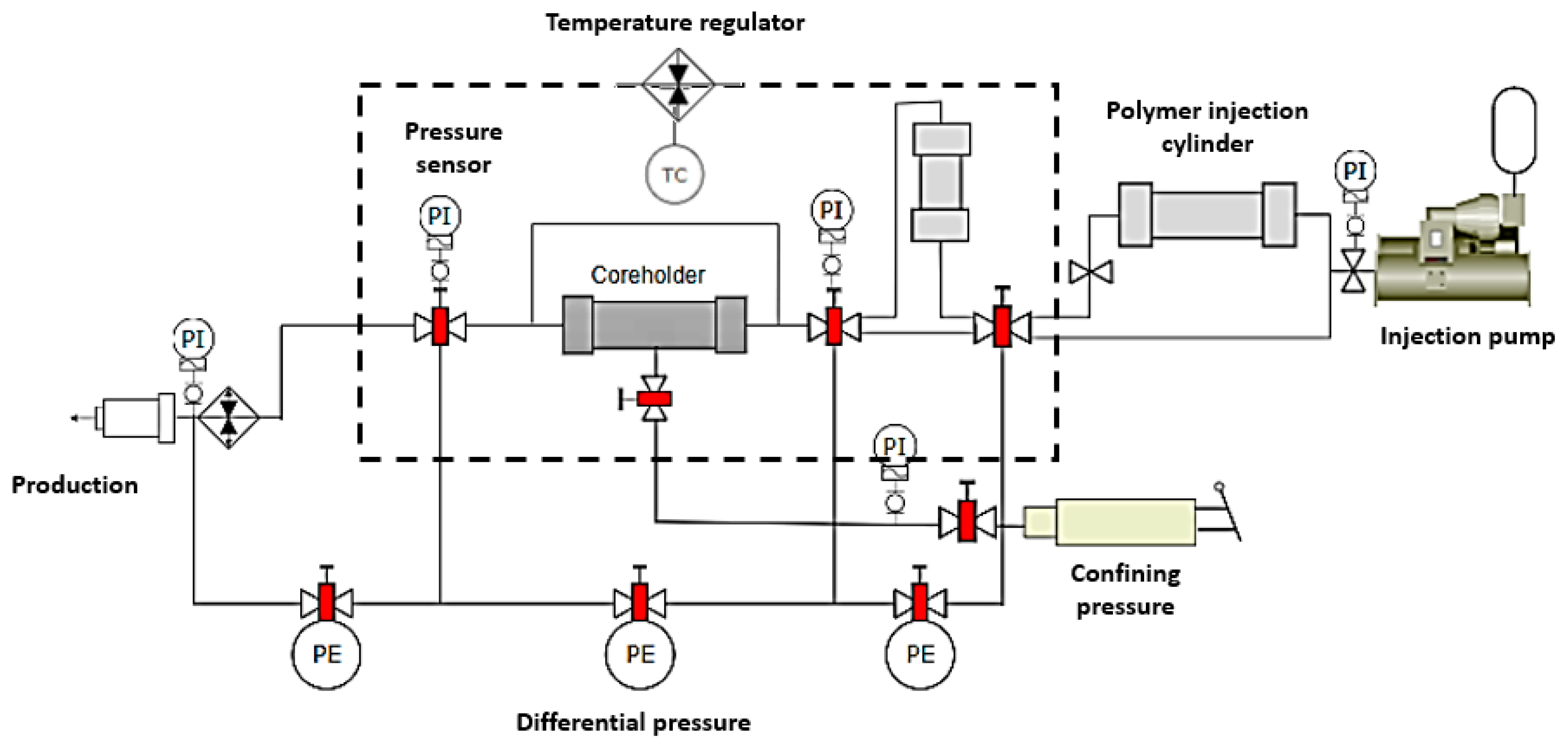

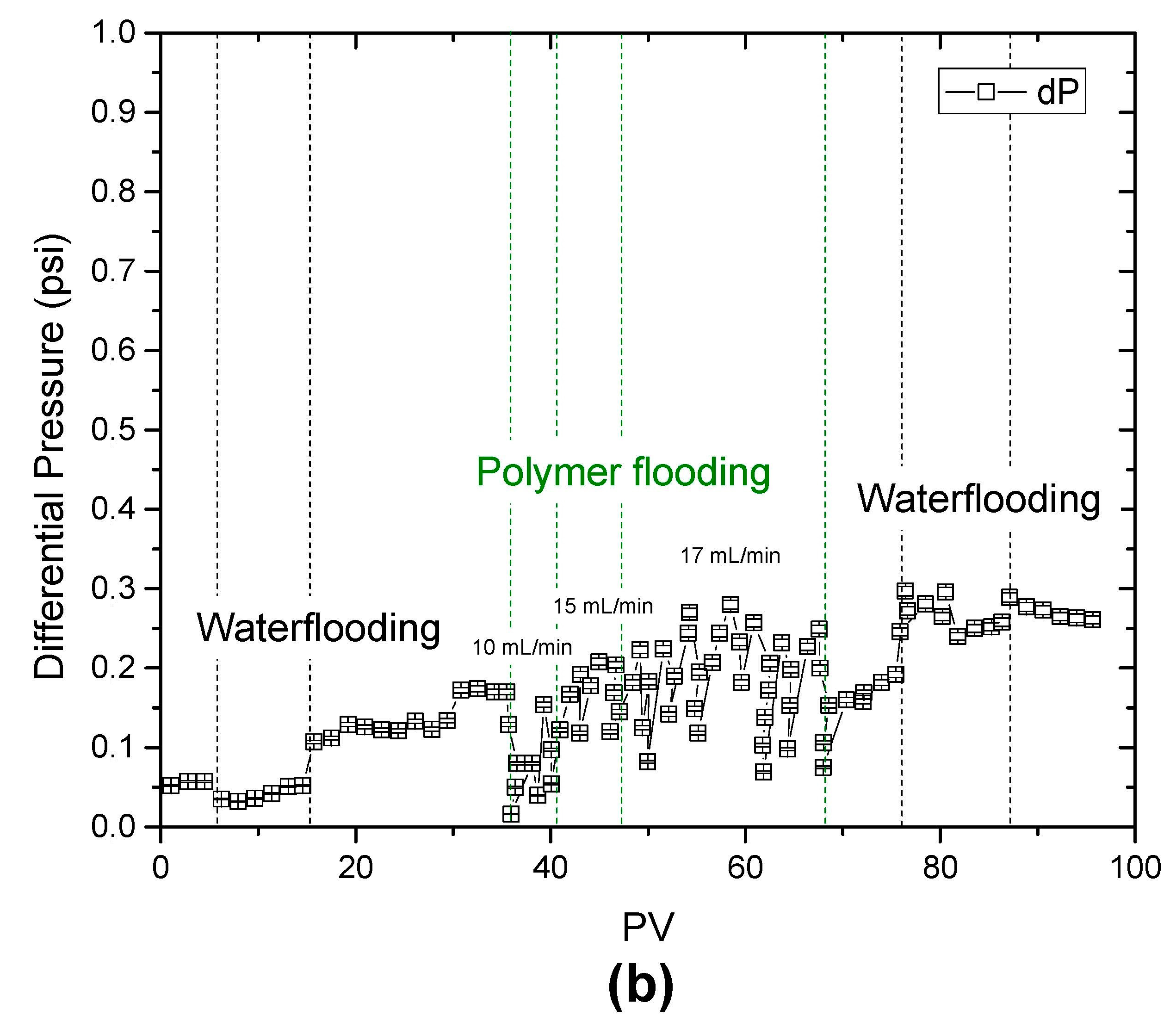
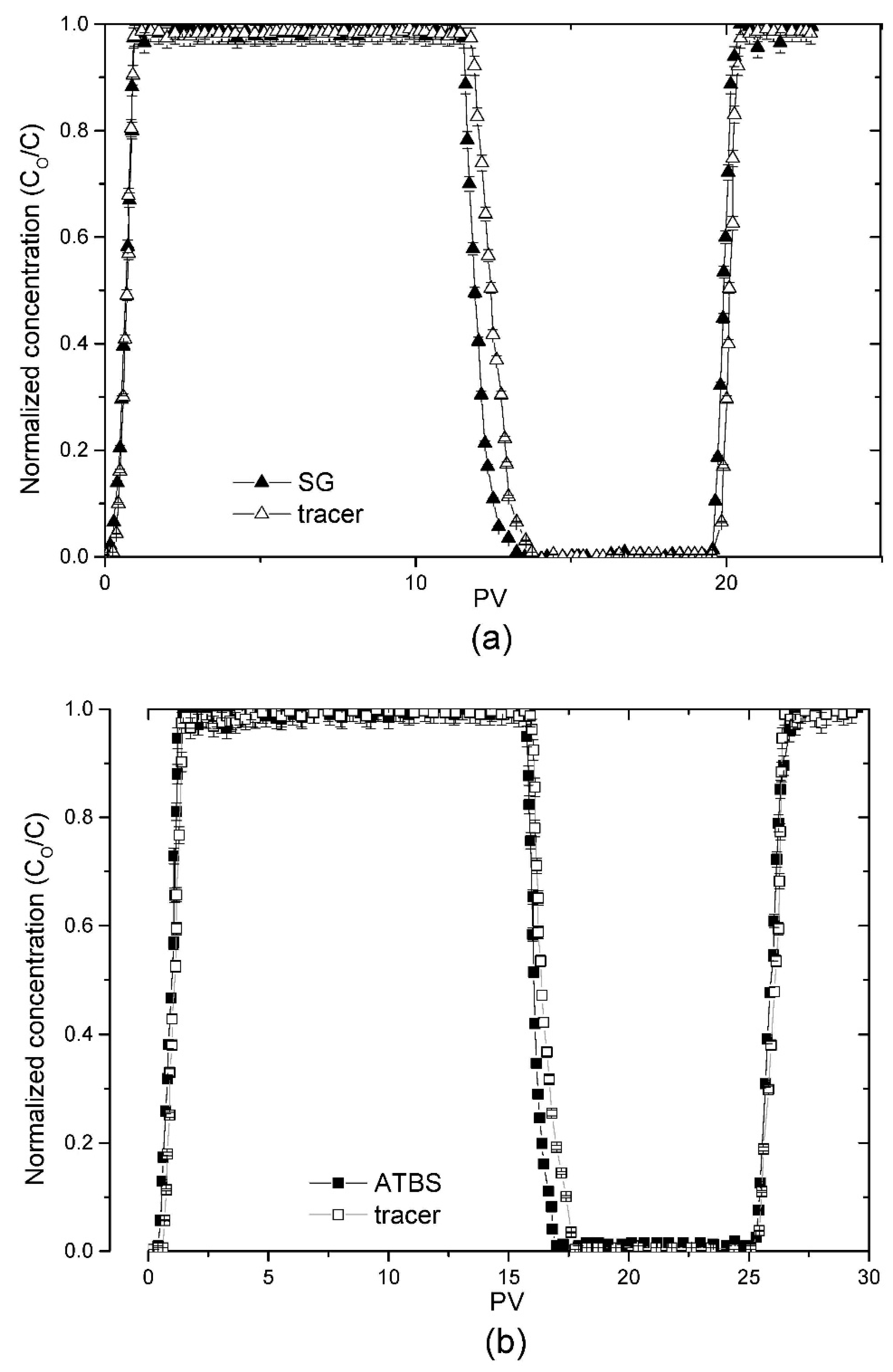

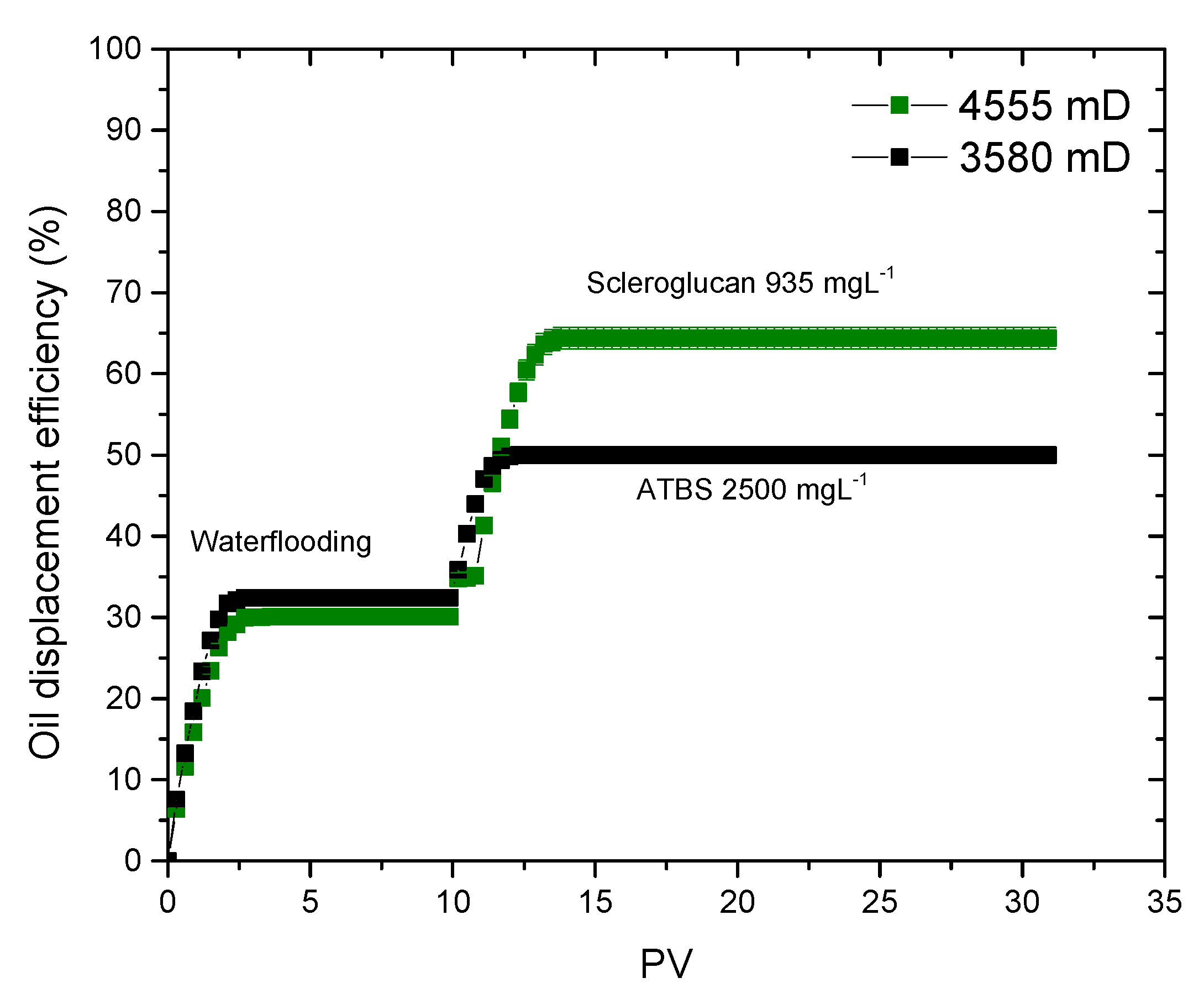
| Gas Permeability (mD) * | Porosity (%) | RF | RRF |
|---|---|---|---|
| 4555 | 20.4 | 1.3 | 2 |
| 2155 | 18.8 | 1.4 | 1.9 |
| Parameters | Rock Properties | Retention | ||||
|---|---|---|---|---|---|---|
| Sample | mgL−1 | µ at 50,000 s−1 | Porosity | Density | Adsorption | IPV |
| (%) | (g/cm3) | (µg/g) | (%) | |||
| ATBS | 2000 | 41.8 | 19.67 | 2.672 | 10.4 | 22 |
| SG | 470 | 15 | 21.93 | 2.676 | 15.4 | 23 |
Publisher’s Note: MDPI stays neutral with regard to jurisdictional claims in published maps and institutional affiliations. |
© 2020 by the authors. Licensee MDPI, Basel, Switzerland. This article is an open access article distributed under the terms and conditions of the Creative Commons Attribution (CC BY) license (http://creativecommons.org/licenses/by/4.0/).
Share and Cite
Castro, R.H.; Llanos, S.; Rodríguez, J.; Quintero, H.I.; Manrique, E. Polymers for EOR Application in High Temperature and High Viscosity Oils: Rock–Fluid Behavior. Energies 2020, 13, 5944. https://doi.org/10.3390/en13225944
Castro RH, Llanos S, Rodríguez J, Quintero HI, Manrique E. Polymers for EOR Application in High Temperature and High Viscosity Oils: Rock–Fluid Behavior. Energies. 2020; 13(22):5944. https://doi.org/10.3390/en13225944
Chicago/Turabian StyleCastro, Rubén H., Sebastián Llanos, Jenny Rodríguez, Henderson I. Quintero, and Eduardo Manrique. 2020. "Polymers for EOR Application in High Temperature and High Viscosity Oils: Rock–Fluid Behavior" Energies 13, no. 22: 5944. https://doi.org/10.3390/en13225944
APA StyleCastro, R. H., Llanos, S., Rodríguez, J., Quintero, H. I., & Manrique, E. (2020). Polymers for EOR Application in High Temperature and High Viscosity Oils: Rock–Fluid Behavior. Energies, 13(22), 5944. https://doi.org/10.3390/en13225944







